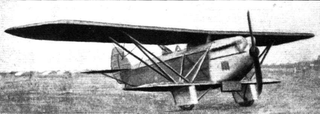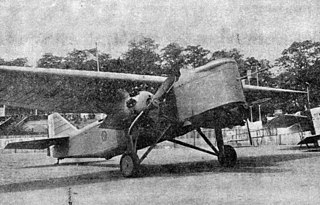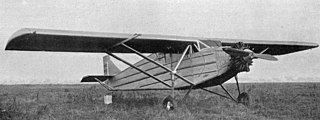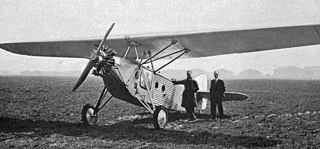
The Blériot 127 was a monoplane bomber aircraft developed and produced by the French aircraft manufacturer Blériot.

The Lioré et Olivier H-190 was a biplane flying boat aircraft designed and produced by the French aircraft manufacturer Lioré et Olivier.

The Dyle et Bacalan DB-10 was a heavy night bomber, designed in France and flown in 1926. It was a twin engine, high wing, metal frame monoplane, distinguished by a very thick centre section wing which formed the forward fuselage and housed the engines.

The SPCA 40T, also designated the SPCA VII, was a mailplane designed and produced by the French aircraft manfacturer Société Provençale de Constructions Aéronautiques (SPCA).

The SPCA Météore 63 was a biplane flying boat airliner designed and built by the French aircraft manufacturer Société Provençale de Constructions Aéronautiques (SPCA). It was the company's first aircraft, as well as the first seaplane to fulfil the strenuous conditions to secure a seaworthiness certificate of the first class and the first long distance seaplane to be procured by the French government.

The Levy Biche LB.2 was a single seat French sesquiplane fighter aircraft designed to be used from aircraft carriers. With a watertight fuselage, jettisonable wheeled undercarriage and small under-wing floats, it could survive emergency sea touchdowns; it could also be fitted with seaplane type floats.
The Lioré et Olivier LeO 8, Lioré et Olivier LeO 8-Cau 2 or Lioré et Olivier LeO 8 CAN 2 was a French two seat, parasol wing monoplane night fighter and reconnaissance aircraft, built in 1923.

The Caudron C.140 was a French tandem cockpit sesquiplane designed in 1928 as a combination of liaison aircraft and observer and gunnery trainer.

The Caudron C.27 was a French biplane, a two-seat basic trainer which also competed successfully in the 1920s.

The Caudron C.43 was the first French five-engined aircraft, a biplane intended for passenger transport or military use and multi-engined for safety. A development of the three-engined Caudron C.39, it had one tractor configuration engine in the nose and two push-pull pairs between the wings. It was capable of carrying eight passengers but was not developed.

The Descamps 17 A.2 was a two-seat reconnaissance fighter built under a French government programme of 1923. Two versions, with different engines, were tested and six examples were built under licence by Caudron as the Caudron C.17 A.2.

The Lioré et Olivier H-23-2 was an amphibious maritime reconnaissance flying boat, built in France in 1932. Three were produced for the Venezuelan Army Air Service.

The Wibault 220 or Wibault R.N.3 220 was a twin-engined French night reconnaissance aircraft. Two were built in 1930 to a government contract.

The CAMS 80 was an amphibious reconnaissance flying boat flown in the early 1930s. Two were built with different engines and were used by the Aéronavale for VIP transport and equipment development until 1938.

The Lioré et Olivier LeO H-23 was a French military flying boat, primarily intended for coastal reconnaissance, though able to carry a small bomb load. Only one was built.

The Hanriot H.34 was a basic trainer designed in France in 1924 which did not reach production. It was a parasol wing aircraft, seating two in tandem.

The Lioré et Olivier Leo H-15 was a French twelve-seat civil flying boat, flown in a national contest in 1926. It did not win but set two load carrying records, one a world record.

The Aviaméta 92 was a French, all-metal, five seat monoplane built in the late 1920s. Three different engines were fitted, and one example flew the first non-stop Paris-Algiers flight in preparation for an abandoned trans-Atlantic attempt.

The CAMS 54 was a strengthened and more powerful version of the French CAMS 51 civil transport and naval reconnaissance flying boat, developed for transatlantic flights. It is sometimes referred to as the 54 GR.

The Hanriot H.46 Styx was a French, single-engined, parasol wing aircraft which could equally be configured for training, liaison or ambulance roles; in the latter form it was able to accept a patient on a stretcher. Several different engines were fitted and flown but the type did not reach production.




















